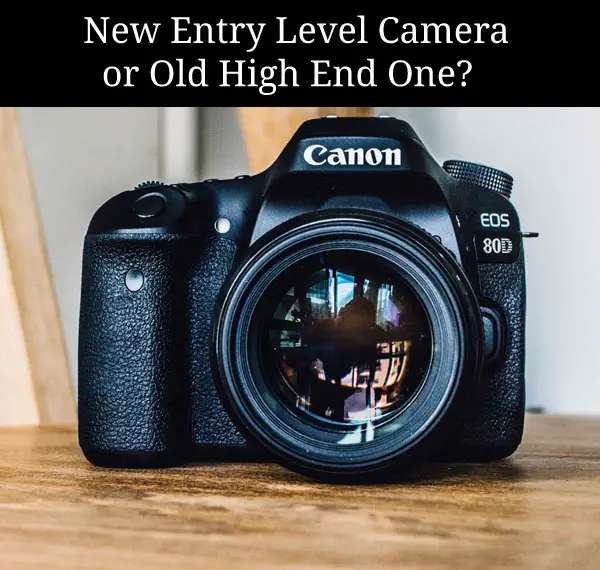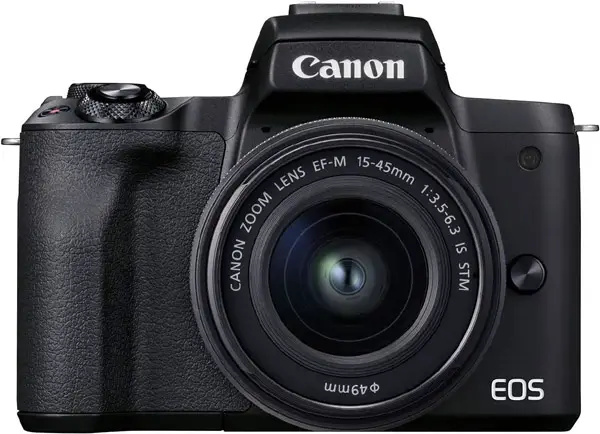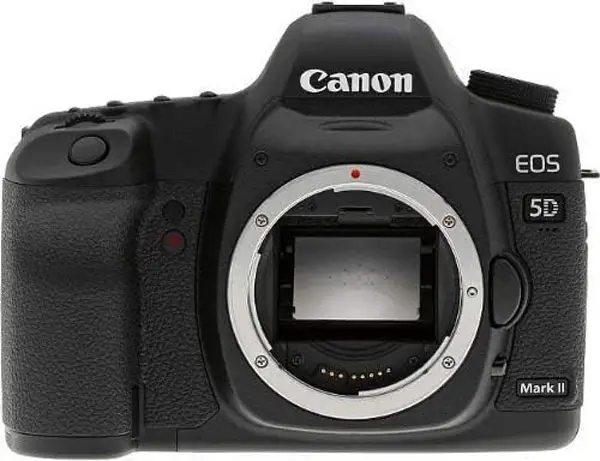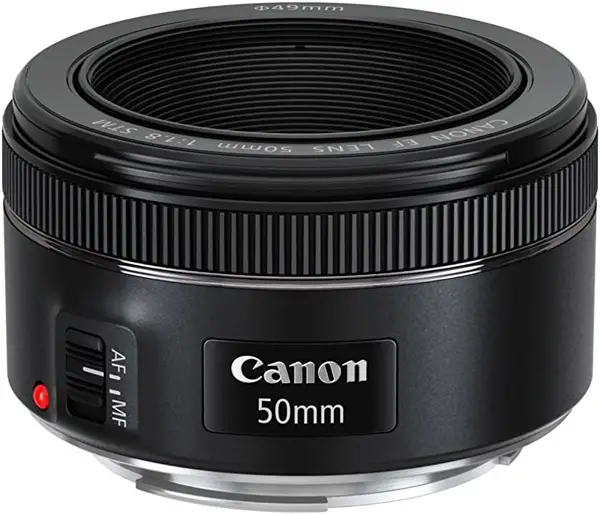New Entry Level Camera or Old High End: What’s Best for YOU?
Choosing between a new entry level camera or an old high end one can be a valid question for both beginner and amateur photographers.

In this article, we delve into factors such as sensor size, image quality, modern features, build quality among others that come into play when making this critical decision.
Understanding the Options
Deciding between a new entry-level camera and an old high-end one can be challenging in this ever-changing tech landscape. This decision isn’t black and white—it depends on your needs as a photographer.
The Allure of New Entry-Level Cameras
Newer entry-level cameras like the Canon EOS M50 Mark II come packed with modern tech features that are hard to resist. Advanced autofocus systems, superior image stabilization and Wi-Fi/Bluetooth connectivity for easy sharing make the Canon EOS M50 Mark II a desirable choice for new photographers.

For beginners in photography, these user-friendly interfaces coupled with automatic modes offer an easier learning curve.
The Charm of Old High-End Cameras
Conversely, classic high-end cameras such as the Canon 5D Mark II have a timeless appeal to experienced photographers. Despite its launch in 2008, this model continues to amaze mid-level photographers with its sturdy build and full-frame sensor which offers superior image quality than the majority of crop-sensor cameras today.

Their sturdy construction makes them perfect companions for outdoor shoots or travel photography.
Making Your Choice: What Matters Most?
Your choice should be guided by what you need from your gear. If cutting-edge features at a lower cost point are important, then consider going for something newer like an entry-level camera.
Exploring the Features of Entry-Level Cameras
When it comes to entry-level cameras, newer models like the Canon EOS M50 Mark II are making waves in the photography world. They are packed with features that were once reserved for high-end professional gear.
The appeal of these beginner-friendly devices lies not only in their affordability but also in their advanced functionalities. Let’s delve deeper into what sets them apart.
The Power and Ease of Modern Camera Technology
First up is the touchscreen interface, a game-changer for camera navigation. This intuitive feature allows you to navigate settings swiftly and efficiently – perfect for those who are still getting the hang of DSLR cameras.
Moreover, these interfaces are not just about navigating menus; they also allow you to focus on your subject by simply tapping where you want your lens to point. It doesn’t get more user-friendly than this.
Moving on to autofocus systems: they have become seriously speedy. The likes of the Canon EOS series offer the Dual Pixel CMOS AF system, which has been widely praised for its focusing speed and accuracy during live view mode – great news if capturing action shots is your thing.
Digital Connectivity: Wi-Fi Capability & More
In today’s digital age, connectivity matters too. Many entry-level mirrorless cameras now come equipped with Wi-Fi capability, allowing easy sharing or transferring of photos directly from your camera to other devices without any hassle – an excellent addition that caters perfectly to our social media-savvy generation.
Evaluating Image Quality in Newbie-Friendly Devices
Sensor size is another critical factor when it comes to image quality in both DSLRs or mirrorless types, particularly at this level. Bigger sensors can capture more light, leading to better picture quality under different lighting conditions.
Don’t overlook that it’s not simply about sensor size. Newer models usually offer better high ISO performance which cuts down noise levels even in low-light situations. This means you get clearer pictures without breaking the bank. But remember, picking between a fresh-out-the-box beginner camera and an older professional one is still your call.
Decoding the High-End Camera: An In-depth Analysis
If you’re in a dilemma between an old high-end camera and a new entry-level one, you’re not alone. Many photography enthusiasts face this choice.
Let’s explore why an older high-end camera such as the Canon 5D Mark II may be a better choice than newer models.
The Longevity and Superior Build of Old High-End Cameras
You may wonder, what makes these older models outlast even some of the newest on the market? The answer lies in their robust construction.
A common feature among old high-end cameras is that they often come with magnesium alloy bodies. This beats plastic casings typically found in entry-level devices hands down when it comes to durability.
But it’s not just about external toughness. Internally too, these machines are built for endurance. Their shutter mechanisms can withstand hundreds of thousands of actuations before any issues arise – something rarely seen in newer models.
The Edge Older Full-Frame Cameras Have Over New Entry-Level Models
Moving beyond build quality, let’s talk image resolution. Here again, older full-frame models score big time thanks to larger sensors capturing more light per pixel than smaller ones found in most new entry-level alternatives.
This means less noise at higher ISO settings – which is great news if you frequently shoot under low-light conditions. It also translates into better highlight detail, giving photographers greater flexibility during post-processing – crucial for achieving professional-grade results every single time.
- Durability matters: The longevity and superior build quality make them stand up against frequent use over long periods.
- Larger Sensors win: With less noise at higher ISOs and improved highlight detail from larger sensors, your images will thank you.
- No compromise on features: Despite being ‘old’, they offer professional-grade features comparable to those available today.
To sum things up, yes, shiny new gear has its appeal, but don’t overlook an old workhorse either. From the outset, they were crafted to fulfill the demands of specialists, thus verifying their durability over time.
Bridging the Gap Between Newer Technology and Pro Features
When it comes to upgrading your photography gear, you may find yourself faced with a crucial question: should you choose a newer entry-level camera or an older high-end model? This decision requires striking a balance between desired features and low-light performance.
Evaluating Low-Light Performance Across Models
The ability to capture high-quality images in dim light is a crucial factor to consider when comparing different camera models. Even entry-level DSLR cameras nowadays come equipped with technology that enhances their performance in challenging lighting conditions.
One standout feature in recent years has been image stabilization, which helps minimize blur caused by minor hand movements during shooting. This feature is especially useful when capturing photos in poorly lit environments that require longer exposure times.
While older high-end models may lack some of the latest technological advancements, they make up for it with superior build quality and advanced settings control. Pro-grade cameras typically have larger sensors, allowing them to capture more light and produce cleaner images with less noise compared to smaller sensor counterparts found in many newer models. Larger sensors tend to deliver better image quality, particularly under poor lighting conditions.
Weighing Desired Features Against Low-Light Performance
When deciding between a new entry-level camera and an old high-end model, it’s essential to factor in not only low-light performance but also other features that complement your photographic approach.
Newer cameras often offer user-friendly interfaces designed for beginners, along with integrated learning tools. These features make them ideal choices if you’re still getting comfortable behind the lens.
On the flip side, an older pro-model will provide more direct control over settings such as shutter speed and aperture size, offering greater creative freedom. However, it could be daunting if you’re not yet familiar with how these settings affect your shots. Understanding these manual controls can significantly improve photographic outcomes, especially for capturing specific artistic effects.
Lens Investment Considerations: The Smart Choice?
Deciding which photographic gear to purchase can be perplexing. Do you go for a shiny new entry-level camera or an older high-end model? Well, here’s another curveball – what about investing in lenses instead?
Unlike cameras that seem to lose value faster than yesterday’s news due to rapid tech advancements and wear-and-tear, lenses have this knack of holding their worth over time.
The Longevity of Lenses
You see, lens technology doesn’t move at the same breakneck speed as digital sensors found in camera bodies. So while your brand-new DSLR might depreciate quicker than you’d like it to, quality lenses tend not to suffer the same fate.
This isn’t some guarantee that all lenses will appreciate or even maintain their value; rather, it’s pointing out that top-notch ones usually experience less depreciation than camera bodies do. This makes them a smarter investment if retaining value is on your checklist.
Making Wise Lens Investments
A smart way of investing in lenses is by going after versatile ones like the 50 mm lens. A solid “nifty fifty” offers excellent image quality and versatility without making your wallet cry for mercy. It works great for various types of photography from portraits to landscapes thanks to its natural field-of-view which matches human vision quite closely.

Another strategy could involve buying older but still top-quality glass compatible with modern systems via adapters. Many premium brands produce superb images despite being several decades old – they may even offer unique aesthetics not found in contemporary designs.
Prioritizing Long-term Value Over Short-Term Savings
In terms of long-term savings and overall photographic capabilities, opting for better optics might give more bang-for-your-buck than frequently upgrading your camera body would ever do. With this approach towards lens investment, you’re essentially buying into an ecosystem where upgrades are mainly driven by advances in optical design rather than simply chasing every incremental improvement offered through new sensor technologies.
Note: Remember folks, this section does not constitute financial advice – always conduct thorough research before making any major purchases.
The Role Of Autofocus In Your Camera Choice
When selecting a camera, the autofocus system can prove to be an essential factor in your decision-making process. This often overlooked feature is crucial in determining your shooting experience.
If you’re transitioning from smartphone photography or just starting out, advanced autofocus technology might be exactly what you need. It simplifies the process of capturing sharp photos and makes newer models incredibly beginner-friendly.
The Impact Of Autofocus On Your Shooting Experience
In recent years, we’ve witnessed significant advancements in autofocus systems. These advancements have made focusing faster and more accurate than ever before.
An improved autofocus not only enhances image quality but also improves the overall user experience. This is especially advantageous for new photographers just beginning their journey with DSLR or mirrorless cameras, as they no longer need to manually adjust focus points; instead, the camera can intelligently select them based on its understanding of the scene.
Gone are the days of manually adjusting focus points; now, you can let your camera intelligently select them based on its understanding of the subjects within the frame.
However, this doesn’t mean that more aged high-end cameras should be disregarded. While they may lack modern autofocus technologies, they often excel in other areas such as sensor size or dynamic range. Depending on your needs and preferences, these factors could outweigh their less sophisticated autofocus capabilities.
Why Choose Used High-End Cameras from Major Retailers?
The draw of top-notch cameras is unmistakable. They promise exceptional image quality and a wide range of advanced features. However, their high price tags can be daunting.
Second-hand models can provide the same premium experience at a significantly reduced cost, while major retailers often offer warranties to guarantee peace of mind. And guess what? Purchasing these gems from major retailers often comes with warranties – providing a safety net against any potential issues after purchase.
A Penny Saved Is A Penny Earned
Budget-conscious photographers know that buying used doesn’t mean compromising on quality. It’s about smart spending and getting more value for your money.
High-end cameras maintain their stellar performance over time due to their robust build quality and superior technology. So why not get top-tier gear without breaking the bank?
Choose Your Vendor Wisely
Your journey towards owning a pre-loved high-end camera begins with selecting reputable retailers who offer warranty protection on second-hand items.
Major sellers typically have stringent inspection processes before listing products, providing detailed insights into each item’s condition right from the start. Additionally, they often have return policies if things don’t go as expected – adding another layer of buyer assurance along with the warranties they provide.
Risk-Free Purchase Experience
No one likes unpleasant surprises when investing in expensive equipment like cameras. With warranties offered by major retailers, you can rest easy knowing you’re covered should any unexpected issues arise after purchase.
Informed Decision Making
Detailed product descriptions give an honest account of each item’s condition, ensuring there are no hidden surprises waiting for you later on. Knowledge is power; use it to ensure your investment pays off both financially and creatively.
FAQs
Should I buy an expensive camera as a beginner?
An expensive camera isn’t necessary for beginners. Starting with an affordable, entry-level model helps you learn the basics before investing in high-end gear.
Are high-end cameras worth it?
Absolutely, if you’re seeking superior image quality and durability. High-end cameras often feature better sensors, build quality, and more advanced options that justify their cost.
Do newer cameras take better photos?
Newer models usually offer improved features like autofocus speed or low-light performance. However, a good photo also depends on your skills as a photographer.
Are older cameras better?
In some aspects such as build quality or sensor size, they can be. But they might lack modern features like touchscreen interfaces or Wi-Fi connectivity found in newer models.
Conclusion
Choosing between a new entry-level camera or an old high-end one is not as straightforward as it might seem. You’ve learned that each option has its own unique set of advantages and challenges.
The modern features, compact size, and advanced autofocus system make the new entry-level cameras appealing to many. However, the superior image quality, robust build, and larger sensor size in older high-end models cannot be ignored either.
Beyond this comparison lies factors like battery life performance and connectivity options, which also play a crucial role. In light of all these considerations, you’re now better equipped to make your choice. Click the following link to learn how to buy a DLSR for beginners.




